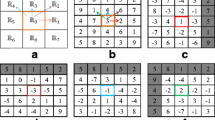Abstract
In recent years, local feature descriptors have received more and more attention due to their effectiveness in the field of face recognition. Local Derivative Patterns (LDPs) for local feature descriptions attract researchers’ great interest. However, an LDP produces 2p different patterns for p neighbors through the transition of LDPs for an image, which lead to high dimension features for image analysis. In this paper, LDPs are expanded to Uniform Local Derivative Patterns (ULDPs) that have the same binary encoding way as LDPs but different transition patterns by introducing uniform patterns. A uniform pattern is the one that contains at most two bitwise transitions from 0 to 1 or vice versa when the binary bit is circular. Then, the number of the transition patterns is reduced from 2p to p(p−1)+3 for p neighbors, e.g., 256 to 59 for p = 8. For face recognition, the histogram features are combined together in four directions, and both non-preprocessed and preprocessed images are used to evaluate the performance of the proposed ULDPs method. Extensive experimental results on three publicly available face databases show that the proposed ULDPs approach has better recognition performance than that obtained by using the LDPs method.














Similar content being viewed by others
References
Belhumeur, P. N., Hespanha, J. P., & Kriegman, D. J. (1997). Eigenfaces vs. Fisherfaces: recognition using class specific linear projection. IEEE Transactions on Pattern Analysis and Machine Intelligence, 19(7), 711–720.
Sirovich, L., & Kirby, M. (1987). Low dimensional procedure for the characterization of human face. Journal of the Optical Society of America, 4(3), 519–524.
Turk, M., & Pentland, A. (1991). Eigenfaces for recognition. Journal of Cognitive Neuroscience, 3(1), 71–86.
Etemad, K., & Chellappa, R. (1997). Discriminant analysis for recognition of human face images. Journal of the Optical Society of America, 14(8), 1724–1733.
Yang, J., Frangi, A. F., Yang, J. Y., Zhang, D., & Jin, Z. (1997). KPCA plus LDA: a complete kernel fisher discriminant framework for feature extraction and recognition. IEEE Transactions on Pattern Analysis and Machine Intelligence, 27(2), 230–244.
Ojala, T., Pietikainen, M., & Harwood, D. (1996). A comparative study of texture measures with classification based on featured distribution. Pattern Recognition, 29(1), 51–59.
Ahonen, T., Hadid, A., and Pietikainen, M. (2004). Face recognition with local binary patterns, in Proc. 8 th European Conference on Computer Vision (pp. 469–481). Prague, Czech Republic.
Ahonen, T., Hadid, A., & Pietikainen, M. (2006). Face description with local binary patterns: application to face recognition. IEEE Transactions on Pattern Analysis and Machine Intelligence, 28(12), 2037–2041.
Tan, X., & Triggs, B. (2010). Enhanced local texture feature sets for face recognition under difficult lighting conditions. IEEE Transactions on Image Processing, 19(6), 1635–1650.
Ahonen T., and Pietikainen M. (2007). Soft histograms for local binary patterns, in Proc. Fin. Signal Process. Symp. (pp. 1–4). Oulu, Finland.
Heikkila, M., Pietikainen, M., & Schmid, C. (2009). Description of interest regions with local binary patterns. Pattern Recognition, 42(3), 425–436.
Liu, C., Jianyun, L., & Li, L. (2011). Three-level face features for face recognition based on center-symmetric local binary pattern. Proceedings IEEE International Conference on Computer Science and Automation Engineering, 4, 394–398.
Pang, Y., Yuan, Y., & Li, X. (2008). IEEE Transactions on Circuits and Systems for Video Technol, 18(7), 989–993.
Zhang, B., Shan, S., Chen, X., & Gao, W. (2007). Histogram of gabor phase patterns (HGPP): a novel objects representation approach for face recognition. IEEE Transactions on Image Processing, 16(1), 57–68.
Zhang, W., Shan, S., Zhang, H., Gao, W., and Chen, X. (2005). Multi-resolution histograms of local variation patterns (MHLVP) for robust face recognition, in Proc. Audio-Video-Based Biometric Person Authentication (pp. 937–944). New York, USA.
Zhang, W., Shan, S., Zhang, H., Gao, W., and Chen, X. (2005). Local gabor binary pattern histogram sequence (LGBPHS): A novel non-statistical model for face representation and recognition, in Proc. IEEE Int. Conf. Computer Vision vo.1, (pp. 786–791). Beijing, China.
Zhang, B., Gao, Y., Zhao, S., & Liu, J. (2010). Local derivative pattern versus local binary pattern: face recognition with high order local pattern descriptor. IEEE Transactions on Image Processing, 19(2), 533–544.
Ojala, T., Pietikainen, M., & Maenpaa, T. (2002). Multiresolution gray-scale and rotation variant texture classification with local binary patterns. IEEE Transactions on Pattern Analysis and Machine Intelligence, 24(7), 971–987.
Castleman, K. R. (1996). Digital image processing [M] (pp. 212–213). Engle wood Cliffs: Prentice Hall.
Zhang, H., Gao, W., Chen, X., & Zhao, D. (2005). Learning informative features for spatial histogram-based object detection. Proceedings IEEE International Joint Conference Neural Networks, 3, 1806–1811.
Phillips, P. J., Moon, H., Rizvi, S. A., & Rauss, P. J. (2000). The FERET evaluation methodology for face-recognition algorithms. IEEE Transactions on Pattern Analysis and Machine Intelligence, 22(10), 1090–1104.
Sim, T., Baker, S., & Bsat, M. (2003). The CMU pose, illumination, and expression database. IEEE Transactions on Pattern Analysis and Machine Intelligence, 25(12), 1615–1618.
Georghiades, A. S., Belhumeur, P. N., & Kriegman, D. J. (2001). From few to many: illumination cone models for face recognition under variable lighting and pose. IEEE Transactions on Pattern Analysis and Machine Intelligence, 23(6), 643–660.
Lee, K. C., Ho, J., & Kriegman, D. J. (2005). Acquiring linear subspaces for face recognition under variable lighting. IEEE Transactions on Pattern Analysis and Machine Intelligence, 27(5), 684–698.
Gao, W., Cao, B., Shan, S., Chen, X., Zhou, D., Zhang, X., & Zhao, D. (2008). The CAS-PEAL large-scale Chinese face database and baseline evaluations. IEEE Transactions on Systems, Man, Cybernetics - Part A: Systems and Humans, 38(1), 149–161.
Beveridge, J. R., Bolme, D., Draper, B. A., & Teixeira, M. (2005). The CSU face identification evaluation system: its purpose, features, and structure. Machine Vision and Applications, 16(2), 128–138.
Acknowledgments
This work is partially supported by “the Fundamental Research Funds for the Central Universities, K50510040013”.
Author information
Authors and Affiliations
Corresponding author
Rights and permissions
About this article
Cite this article
Ren, H., Sun, J., Hao, Y. et al. Uniform Local Derivative Patterns and Their Application in Face Recognition. J Sign Process Syst 74, 405–416 (2014). https://doi.org/10.1007/s11265-012-0728-9
Received:
Revised:
Accepted:
Published:
Issue Date:
DOI: https://doi.org/10.1007/s11265-012-0728-9




